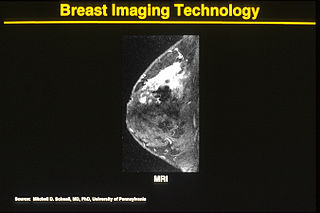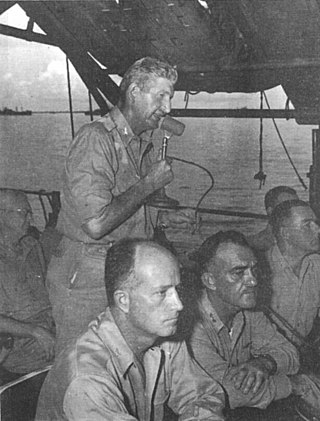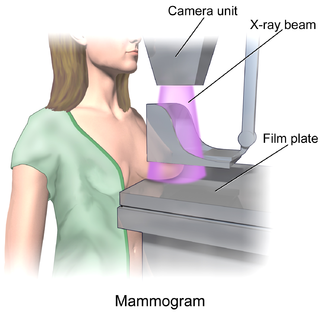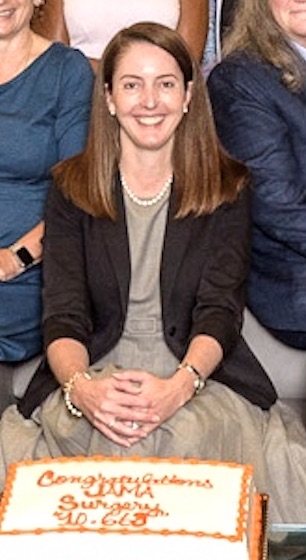Related Research Articles

Mammography is the process of using low-energy X-rays to examine the human breast for diagnosis and screening. The goal of mammography is the early detection of breast cancer,typically through detection of characteristic masses or microcalcifications.

Beth Israel Deaconess Medical Center (BIDMC) in Boston,Massachusetts is a teaching hospital of Harvard Medical School. It was formed out of the 1996 merger of Beth Israel Hospital and New England Deaconess Hospital. Among independent teaching hospitals,Beth Israel Deaconess Medical Center has ranked in the top three recipients of biomedical research funding from the National Institutes of Health. Research funding totals nearly $200 million annually. BIDMC researchers run more than 850 active sponsored projects and 200 clinical trials. The Harvard-Thorndike General Clinical Research Center,the oldest clinical research laboratory in the United States,has been located on this site since 1973.
The American College of Radiology (ACR),founded in 1923,is a professional medical society representing nearly 40,000 diagnostic radiologists,radiation oncologists,interventional radiologists,nuclear medicine physicians and medical physicists.

One alternative to mammography,breast MRIor contrast-enhanced magnetic resonance imaging (MRI),has shown substantial progress in the detection of breast cancer.
BI-RADS is an acronym for Breast Imaging-Reporting and Data System,a quality assurance tool originally designed for use with mammography. The system is a collaborative effort of many health groups but is published and trademarked by the American College of Radiology (ACR).

Breast cancer screening is the medical screening of asymptomatic,apparently healthy women for breast cancer in an attempt to achieve an earlier diagnosis. The assumption is that early detection will improve outcomes. A number of screening tests have been employed,including clinical and self breast exams,mammography,genetic screening,ultrasound,and magnetic resonance imaging.

Molecular breast imaging (MBI), also known as scintimammography, is a type of breast imaging test that is used to detect cancer cells in breast tissue of individuals who have had abnormal mammograms,especially for those who have dense breast tissue,post-operative scar tissue or breast implants.
Daniel B. Kopans,MD,FACR is a radiologist specializing in mammography and other forms of breast imaging.
The Digital Mammographic Imaging Screening Trial (DMIST) is a multi-institutional research study,beginning in 2001,on the efficacy for screening of full-field digital mammography (FFDM) compared to conventional film-screen mammography that was sponsored by the U.S. National Cancer Institute and performed by the American College of Radiology Imaging Network (ACRIN).
Thomas M. Kolb is an American radiologist specializing in the detection and diagnosis of breast cancer in young,predominantly high-risk premenopausal women. He has served as an assistant clinical professor of Radiology at Columbia University College of Physicians and Surgeons from 1994–2010. Kolb is double board certified,having received his training in pediatrics at the Albert Einstein College of Medicine in Bronx,New York,and in diagnostic radiology at the Columbia-Presbyterian Medical Center in New York.

Stafford Leak Warren was an American physician and radiologist who was a pioneer in the field of nuclear medicine and best known for his invention of the mammogram. Warren developed the technique of producing stereoscopic images of the breast with X-rays while working in the Department of Radiology at the University of Rochester School of Medicine.
The Canadian National Breast Screening Study,sometimes abbreviated as CNBSS or NBSS,was a randomized trial conducted with the aim of evaluating whether mammography reduced breast cancer incidence or mortality among women who underwent screening. The trial was initiated in 1980,and was conducted in fifteen screening centers in six different Canadian provinces. It was the first study designed to determine whether mammography was effective among women between the ages of 40 and 49.

In medicine,breast imaging is a sub-speciality of diagnostic radiology that involves imaging of the breasts for screening or diagnostic purposes. There are various methods of breast imaging using a variety of technologies as described in detail below. Traditional screening and diagnostic mammography uses x-ray technology and has been the mainstay of breast imaging for many decades. Breast tomosynthesis is a relatively new digital x-ray mammography technique that produces multiple image slices of the breast similar to,but distinct from,computed tomography (CT). Xeromammography and galactography are somewhat outdated technologies that also use x-ray technology and are now used infrequently in the detection of breast cancer. Breast ultrasound is another technology employed in diagnosis and screening that can help differentiate between fluid filled and solid lesions,an important factor to determine if a lesion may be cancerous. Breast MRI is a technology typically reserved for high-risk patients and patients recently diagnosed with breast cancer. Lastly,scintimammography is used in a subgroup of patients who have abnormal mammograms or whose screening is not reliable on the basis of using traditional mammography or ultrasound.
Fiona Jane Gilbert is a Scottish radiologist and academic.
Marjorie Clare Dalgarno (1901–1983) was an Australian radiologist and a pioneer of mammography. She performed the first mammogram in Australia at the Rachel Forster Hospital and demonstrated the benefits of mammography as a breast cancer screening tool.
Nola M. Hylton is an American oncologist who is Professor of Radiology and Director of the Breast Imaging Research Group at the University of California,San Francisco. She pioneered the usage of magnetic resonance imaging for the detection,diagnosis,and staging of breast cancer by using MRIs to locate tumors and characterize the surrounding tissue.
Judy Yee is an American radiologist. She is the University Chair of Radiology at Montefiore and professor of radiology at Albert Einstein College of Medicine.

Melina R. Kibbe is an American clinician and researcher in the field of vascular surgery. She currently serves as Dean of the University of Virginia School of Medicine. She previously held the Colin G. Thomas Jr. Distinguished Professorship and Chair of the Department of Surgery at UNC School of Medicine.
Elizabeth Margaret Forbes was a Canadian radiologist. Forbes was the Chief of Radiology at Toronto's Women's College Hospital (WCH) from 1955 to 1975. She is remembered for co-authoring “one of the first Canadian papers on mammography”with WCH's Henrietta Banting.
Dense breast tissue,also known as dense breasts,is a condition of the breasts where a higher proportion of the breasts are made up of glandular tissue and fibrous tissue than fatty tissue. Around 40–50% of women have dense breast tissue and one of the main medical components of the condition is that mammograms are unable to differentiate tumorous tissue from the surrounding dense tissue. This increases the risk of late diagnosis of breast cancer in women with dense breast tissue. Additionally,women with such tissue have a higher likelihood of developing breast cancer in general,though the reasons for this are poorly understood.
References
- 1 2 "Etta D. Pisano, MD" (PDF). acadrad.org. Retrieved August 5, 2020.
- 1 2 "Gold Medalist Tribute-Etta D. Pisano, MD" (PDF). aur.org. Archived from the original (PDF) on December 4, 2020. Retrieved August 5, 2020.
- 1 2 3 McNichol, Beth (2010). "A Brilliant Impatience". pp. 2–4. Retrieved August 6, 2020.
- 1 2 "Dr. Pisano accepts appointment at the Medical University of South Carolina". unchealthcare.org. April 1, 2010. Archived from the original on August 9, 2020. Retrieved August 6, 2020.
- ↑ "New Breast-imaging Technology Could Save More Women's Lives". sciencedaily.com. July 23, 2004. Retrieved August 6, 2020.
- ↑ "Digital Mammography More Accurate in Younger Women". cancernetwork.com. October 1, 2005. Retrieved August 6, 2020.
- 1 2 "UNC's Pisano, Rimer elected to Institute of Medicine". news.unchealthcare.org. 2008. Archived from the original on September 28, 2015. Retrieved August 6, 2020.
- ↑ "UNC Faculty Members Named to Distinguished Professorships". newswise.com. February 9, 2006. Retrieved August 6, 2020.
- ↑ "UNC and GE Healthcare partner to create Center for Research Excellence in Breast Cancer Imaging". news.unchealthcare.org. March 5, 2007. Retrieved August 6, 2020.[ permanent dead link ]
- ↑ "Dr. Pisano to serve as Principal Investigator for CTSA". news.unchealthcare.org. 2008. Archived from the original on September 21, 2020. Retrieved August 6, 2020.
- ↑ "Etta Pisano Leaving for Deanship in S.C." alumni.unc.edu. April 1, 2010. Retrieved August 6, 2020.
- ↑ Barker, Ashley (September 8, 2014). "MUSC president to choose new dean to replace Pisano in College of Medicine". scbiznews.com. Archived from the original on January 10, 2023. Retrieved August 6, 2020.
- ↑ "Where Are They Now?". radnet.bidmc.harvard.edu. Retrieved August 6, 2020.
- ↑ "Radical Views Medical Center from the Department of Radiology" (PDF). radnet.bidmc.harvard.edu. November 2015. Retrieved August 6, 2020.
- ↑ "TMIST breast cancer screening trial begins to enroll nearly 165,000 women". medicalxpress.com. September 26, 2017. Retrieved August 6, 2020.
- ↑ Forsythe-Stephens, Keri (September 1, 2017). "Etta Pisano Named ACR Center for Research and Innovation Chief Science Officer". 24x7mag.com. Retrieved August 6, 2020.
- ↑ Rohman, Melissa (October 4, 2018). "ACR appoints 1st female chief research officer, Etta Pisano". healthimaging.com. Retrieved August 6, 2020.